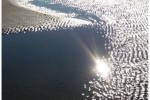Earth is Geology’s Classroom
Growing up in Hawaii, I’ve been to my fair share of beaches. They’re great; they’re peaceful; they’re fun. Until last week, I never would have thought of the beach as a classroom and a map of clues to show you the history of the area. Lucky for me, I chauffeured a field trip for Leslie “Doc” Sautter’s Marine Geology Lab to the beach and got to see the beach and its coastal processes in action.
Doc is known as the queen of all things marine here at the College of Charleston Geology department and now I know why. I learned a lot in those few hours! It confirmed to me how amazing our faculty is at what they do. I may have forgotten most of the terminology I learned that day, but I don’t think I’ll forget how the processes work, how coastal processes affect humans, and how humans in turn affect the coast. More importantly, I know some neat tidbits that I can share with my friends and family when we go to the beach.

Beach terminology
These are my favorite takeaways from the field trip:
–Inlets are dangerous! As the tide goes down (ebb tide – Wow! I remember a bit of the terminology), the channel becomes more narrow and turbulent. It can take a person down when they’re not looking. We stopped at Breach Inlet, right past Sullivan’s Island in the Isle of Palms, that’s claimed many lives. BE CAREFUL!
–Dunes need plants to keep the sand and remain a dune. Don’t go traipsing around in them to topple them. Don’t cut the plants, even if they’re pretty. It is awesome to see how some grasses grow with the dunes. You can see how as the top of the grass is covered by sand, it grows another root ball so it can grow taller again. We saw one at the edge of the dune that had three root balls. I had no idea!
Other cool things we saw:
– The inlet’s Ebb Tidal Delta and its swash (sand) bars
– Wavy patterns in the sand called ripples that show how fast the water was going
– Bubble sand! This is where air has bubbled up through saturated sand, leaving voids.
– Waves refracting, showing you how the current (and longshore transport) is coming down the coast
I love that our faculty and department have the resources and gumption to go out and show students that the Earth is a geology classroom. Hopefully it was as memorable a lesson for the rest of the students as it was for me. I can’t wait to chauffeur for more geology field trips!
Here are a few upcoming field trips and field opportunities that I know of:
- Walking tours of Charleston to see old earthquake damage
- Mineralogy field trip to wine country in NC to see how topography and soil affects grape varieties and harvests
- Congaree National Park trip for hydrology field research
- Class during winter break to study carbonate environments at the Gerace Research Centre on the island of San Salvador in The Bahamas
- Summer class to the Galapagos Islands for “Volcanoes in the Footsteps of Darwin”
It’s going to be hard to choose! What field experience has been your favorite? What field opportunity are you looking forward to the most?




